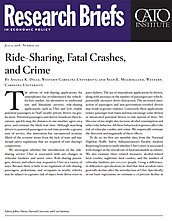We investigate whether the introduction of the ridesharing service Uber is associated with net changes in vehicular fatalities and arrest rates. Ride-sharing passengers, drivers, and others may respond to Uber in a variety of ways. Because there is little to no regulation of ride-sharing, passengers, pedestrians, and occupants in nearby vehicles may be subject to a greater risk of injury from driver error or parts failures. The use of smartphone applications by drivers, along with increases in the number of passengers per vehicle, potentially increases driver distraction. The increased interaction of passengers and non-government-certified drivers may result in greater violence. Conversely, these applications reduce passenger wait times and may encourage some drowsy or intoxicated potential drivers to ride instead of drive. Yet this ease of use might also increase alcohol consumption and other risky behavior. All these behavioral responses affect the risk of vehicular crashes and crime. We empirically estimate the direction and magnitude of these effects.
To do so, we first use monthly data from the National Highway Traffic Safety Administration’s Fatality Analysis Reporting System to study whether Uber’s entry is associated with changes in the overall rate of fatal automobile accidents. We also examine three related measures: alcohol-related fatal crashes, nighttime fatal crashes, and the number of vehicular fatalities per 100,000 people. Using a difference in-differences specification, we find that fatal accident rates generally decline after the introduction of Uber. Specifically, in our basic regressions, we estimate a 1.6 percent decline in the overall fatal crash rate for each additional quarter Uber is available. For alternate results, we observe a 0.7 percent decline for each quarter Uber is available. These results are robust to a variety of specifications. For some specifications, we also observe a reduction in the rate of fatal crashes involving alcohol and fatal crashes at night and in the number of vehicular fatalities for the months following the introduction of Uber.
Next, we use the Federal Bureau of Investigation’s Uniform Crime Reporting program to explore whether the introduction of Uber is associated with changes in arrests for particular types of crime: aggravated assaults, other assaults, motor vehicle thefts, driving under the influence (DUI), drunkenness, and disorderly conduct. Again, employing a difference-in-differences specification with county-specific trends, we typically find a decline in the arrest rate for DUIs. Recognizing that it takes time for potential users to become aware of the service and for current users to become more familiar with the ride-sharing application, in our basic results we estimate a 0.8 percent decline in DUIs for each additional month Uber is available. For most specifications, we also observe declines in the arrest rates for other crimes, but those tend to be imprecisely estimated. However, the arrest rate for motor vehicle theft increases.
Overall, ride-sharing applications have good effects for traffic safety and crime. The ease of use, quick response time, and point-to-point transportation convenience promote safety. All three mechanisms are especially important when potential riders are out late and not in a sound condition to drive themselves home.
NOTE
This research brief is based on Angela K. Dills and Sean E. Mulholland, “Ride-Sharing, Fatal Crashes, and Crime,” Southern Economic Journal 84, no. 4 (April 2018): 965–91.
